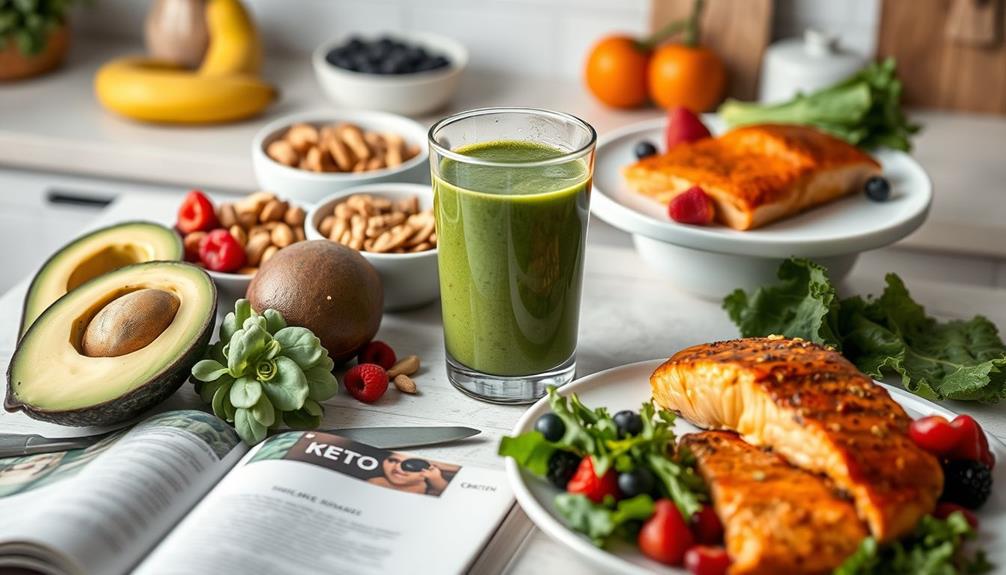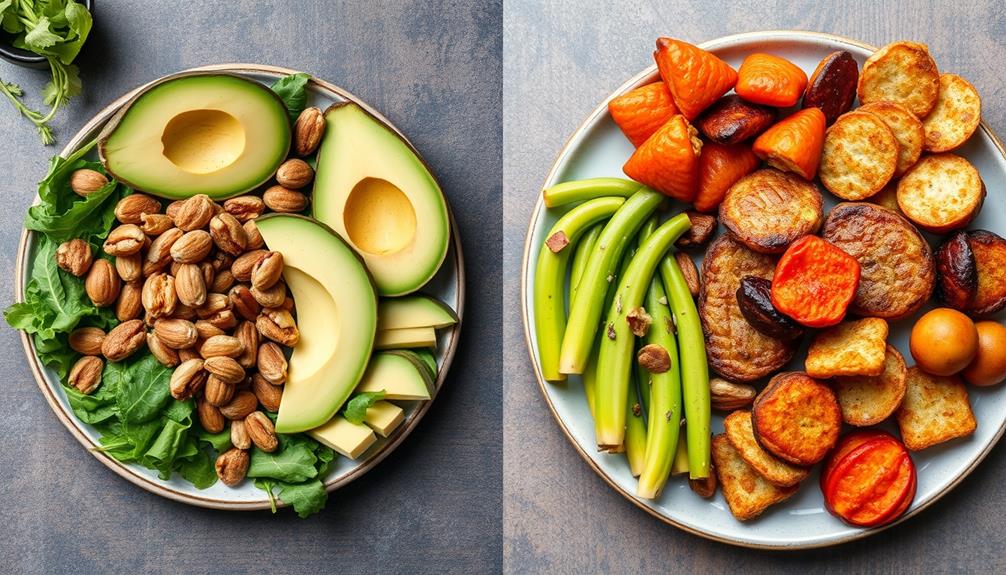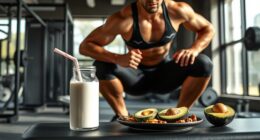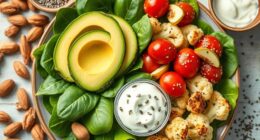To start the keto diet at home, focus on eating high-fat, low-carb foods. Limit your daily carb intake to 20-50 grams and aim for a macro ratio of 70-75% fat, 20-25% protein, and 5-10% carbohydrates. Include essentials like avocados, nuts, fatty fish, and leafy greens while avoiding sugary and starchy foods. Stay hydrated; drink plenty of water to help manage potential "keto flu" symptoms. Meal prepping and tracking your progress can keep you on track. As you implement these guidelines, you'll discover more tips to make your keto journey smoother and more enjoyable.
Key Takeaways
- Limit carbohydrate intake to 20-50 grams per day to achieve and maintain ketosis.
- Focus on high-fat foods like avocados, nuts, and fatty meats while avoiding sugary and starchy foods.
- Prepare a weekly meal plan with keto-friendly recipes and batch cook for convenience.
- Stay hydrated by drinking 6-8 glasses of water daily to support metabolic functions and prevent dehydration.
- Monitor electrolyte levels, especially sodium, potassium, and magnesium, to avoid symptoms of keto flu.
Understanding the Keto Diet

What exactly is the Keto Diet? The ketogenic diet is a high-fat, low-carbohydrate eating plan designed to shift your body into a metabolic state called ketosis. In ketosis, your body burns fat for energy instead of relying on carbohydrates.
To achieve this, you'll need to limit your carbohydrate intake to about 20-50 grams per day. This restriction is essential for triggering ketosis, so it's important to track your food choices carefully and avoid hidden carbs.
Prioritize foods like avocados, nuts, seeds, fatty fish, and low-carb vegetables. These foods will help you reach the macronutrient ratio of approximately 70-75% fat, 20-25% protein, and only 5-10% carbohydrates.
Additionally, incorporating high-antioxidant options like celery juice can support your overall health while on the keto diet. You'll want to steer clear of starchy foods like bread, pasta, grains, and most fruits to stay on track.
While the keto diet can help with weight loss and other health benefits, be prepared for some initial side effects known as the "keto flu." You might feel fatigued or irritable as your body adjusts to this new energy source, but these symptoms usually resolve within a few weeks.
Key Benefits of Keto

Embracing the Keto Diet can lead to a range of impressive benefits that go beyond just weight loss. Many people experience considerable weight loss, often shedding 2 pounds more than those on low-fat diets in the initial months. This rapid weight loss can boost your motivation and commitment to the diet.
Additionally, incorporating mindfulness practices can further enhance your journey by helping reduce emotional eating, making it easier to stick to your meal plan.
The Keto Diet also improves blood sugar control, making it especially beneficial for those with type 2 diabetes. Studies show that about 60% of participants can reverse their condition by sticking to the diet. This enhanced blood sugar management translates to increased energy levels and reduced cravings.
Additionally, the Keto Diet can sharpen your mental clarity and cognitive function. Ketones produced from fat serve as an efficient fuel source for your brain, potentially leading to better focus and productivity.
Beyond these benefits, Keto offers neuroprotective effects, helping reduce seizure frequency in drug-resistant epilepsy patients, particularly in children.
You may also notice improved cholesterol levels, with reduced triglycerides and increased HDL (good) cholesterol. Overall, the health benefits of the Keto Diet can considerably enhance your quality of life.
Risks and Precautions

As you start the keto diet, be aware of the potential for nutrient deficiencies due to limited food variety.
If you have any pre-existing medical conditions, especially related to your liver, kidneys, or heart, it's essential to consult a healthcare provider before making any changes.
Taking these precautions can help you navigate the risks more safely.
Potential Nutrient Deficiencies
Following the Keto Diet can pose risks for potential nutrient deficiencies due to its restrictive nature. With limited food variety, you're likely to miss out on essential vitamins like A, C, K, and certain B vitamins, along with minerals such as magnesium, potassium, and calcium. This can lead to inadequate fiber intake, which is fundamental for digestive health and maintaining gut microbiota diversity.
Additionally, incorporating healthy fats, such as those from butter as a nutrient source, can help provide essential vitamins A, D, E, and K while enhancing the flavor of your meals.
To combat these deficiencies, it's important to incorporate a wide range of low-carb vegetables, nuts, and seeds into your meals. These foods can provide critical nutrients while keeping you within your carb limits. Additionally, consider using supplements to fill any gaps in your diet. Regular monitoring of your nutrient levels through blood tests can help you identify deficiencies early on, allowing you to adjust your diet or supplementation as needed.
Long-term adherence to the Keto Diet without proper planning can increase the risk of oxidative stress and inflammation due to a decreased intake of antioxidant-rich foods.
As a result, being proactive about your nutrient intake is essential for maintaining your health while following the Keto Diet.
Medical Conditions Consideration
Considering the potential nutrient deficiencies associated with the Keto Diet, it's also important to be aware of how existing medical conditions might influence your experience. Individuals with emotional dysregulation, such as those with Borderline Personality Disorder, may find that the keto diet impacts their mood and emotional stability.
If you have pre-existing medical conditions like heart disease, liver disease, or kidney problems, consulting a healthcare professional before starting the keto diet is essential. This diet could exacerbate your condition and lead to serious complications.
For those with diabetes, especially type 1, caution is critical. The keto diet can cause dangerously low blood sugar levels if you don't monitor your levels and adjust your insulin accordingly. If you're on diabetes medications, particularly insulin, seek medical advice to avoid the risk of hypoglycemia, which can occur due to reduced carbohydrate intake.
Additionally, if you're pregnant or nursing, the keto diet may not be safe, as its effects on fetal development and lactation aren't well-studied.
Regular monitoring of your cholesterol levels is also recommended, as some individuals may experience elevated cholesterol, potentially increasing the risk of cardiovascular issues.
Always prioritize your health and consult a healthcare provider to confirm the keto diet is suitable for your specific medical conditions.
Essential Foods to Include

To successfully navigate the keto diet at home, it's crucial to stock your kitchen with essential foods that align with its high-fat, low-carb principles. Focus on high-fat foods like avocados, olive oil, coconut oil, nuts, and seeds, which can be considered part of a diversification strategy for your diet. When it comes to protein, prioritize options like salmon, beef, and eggs, while also incorporating low-carb vegetables such as leafy greens, broccoli, and cauliflower. By sticking to these keto diet basics, you can ensure that your meals are both delicious and compliant with the principles of the diet. This will help you stay on track and achieve your health and wellness goals.
These should make up about 60%-80% of your daily caloric intake on this high-fat diet.
You'll also want to include high-quality protein sources to support your protein intake while keeping carbs low. Fatty fish such as salmon and mackerel, grass-fed meats like beef and pork, and eggs are excellent choices.
They help you meet your protein needs without exceeding carbohydrate limits.
Incorporate low-carb vegetables like leafy greens (spinach, kale), cruciferous veggies (broccoli, cauliflower), and peppers.
These nutrient-dense options provide fiber while keeping your carb counts low.
Lastly, stock up on keto-friendly snacks like cheese, hard-boiled eggs, and pork rinds.
They'll be essential for managing hunger between meals while staying within your carb limits.
Foods to Avoid

When starting your keto diet journey, it's essential to know which foods can derail your progress. First and foremost, avoid sugary foods like soda, fruit juices, candies, and desserts. These items can greatly increase your carbohydrate intake and hinder your ability to reach ketosis.
Additionally, being aware of potential health issues, such as breast cancer symptoms, can provide important context for maintaining a healthy lifestyle while on a keto diet.
Next, steer clear of grains, including wheat, rice, pasta, and bread. These staples are high in carbohydrates and can easily disrupt your low-carb goals.
Most fruits should also be limited due to their natural sugar content. If you do indulge, stick to low-glycemic options like berries, and consume them in moderation.
Don't forget about starchy vegetables. Eliminate potatoes, carrots, and corn from your meals, as they contain higher levels of carbohydrates that can impede ketosis.
Meal Planning Strategies

When planning your keto meals, start by creating an essential food list that prioritizes low-carb, high-fat options.
Incorporating mindful beverage choices, like different brewing methods, can enhance your experience and support your dietary goals.
Set aside time each week for meal prep to streamline your cooking and make healthier choices easier.
Don't forget to include keto-friendly snacks to keep you satisfied between meals and on track with your goals.
Essential Food List
Creating a crucial food list for your keto diet at home is key to staying on track and making meal planning simpler. Start by focusing on high-fat, low-carb foods that will help you maintain ketosis. Stock up on fatty cuts of meat, like ribeye or salmon, and full-fat dairy products, such as cheese and heavy cream.
Don't forget to include healthy fats, like olive oil, coconut oil, and butter, which are important for reaching your macronutrient goals. Additionally, consider incorporating essential oils for respiratory health, as they can support overall well-being during your keto journey.
Incorporate plenty of low-carb vegetables like spinach, zucchini, and broccoli to add fiber and crucial nutrients without exceeding your carb limit. Aim to keep your daily carb intake below 50 grams, so avoid starchy foods like bread, pasta, and rice.
Plan your meals and snacks ahead of time to steer clear of high-carb temptations. Consider preparing keto-friendly recipes in batches for added convenience.
Weekly Meal Prep
Planning your weekly meals is a game-changer for sticking to the keto diet at home. Start by crafting a detailed meal plan that highlights keto-friendly recipes. Focus on incorporating high-fat foods like meats, avocados, and a variety of low-carb vegetables while keeping your daily carb intake below 50 grams.
Additionally, consider how your astrological sign may influence your self-discipline and motivation, as some signs might've a natural tendency to stick to a routine more effectively, potentially optimizing your meal prep efforts. Astrology and Attractiveness can also play a role in how you feel about the foods you prepare and consume.
To streamline your week, utilize meal prep containers to portion out your meals. This helps with portion control and guarantees you always have a keto-friendly option ready, even on busy days. Batch cooking proteins—like grilling several chicken breasts or slow-cooking beef—saves time and keeps your meals accessible.
Enhance your meal plan by preparing different sauces, dressings, and seasonings to keep things exciting. Variety is key to preventing boredom and sticking to your diet.
Finally, make a shopping list based on your meal plan. This tactic helps you avoid impulse purchases and ensures you have all the necessary ingredients on hand.
With these strategies in place, you'll find it much easier to stay committed to your keto journey while enjoying delicious meals throughout the week.
Snack Options Guide
Snacking can make or break your keto journey, so it's essential to stock up on the right options. Choose high-fat, low-carb snacks to maintain ketosis while satisfying hunger between meals. Options like cheese, nuts, avocados, and olives are excellent choices that provide both flavor and nutrition.
Additionally, consider incorporating natural remedies that can complement your dietary efforts and support overall health.
Incorporate keto-friendly snacks such as pork rinds, beef jerky, or hard-boiled eggs. These snacks deliver protein and healthy fats without exceeding your carb limits. For a quick treat, prepare homemade snacks like almond flour-based cookies or fat bombs made with coconut oil and nut butter.
Don't forget to include low-carb vegetables in your snack rotation. Pair celery, cucumber, or bell peppers with high-fat dips like guacamole or ranch dressing to create nutritious options that align with keto principles.
Keep your portion sizes in check. Aim for snacks that contribute to your daily macronutrient goals without pushing your carb intake above 20-30 grams per day.
With these strategies, you can enjoy delicious snacks while staying on track with your keto diet.
Cooking Tips for Keto

Mastering the art of keto cooking at home can transform your meals into satisfying and flavorful experiences. To successfully embrace the keto lifestyle, focus on high-fat ingredients that keep your meals delicious and in line with the macronutrient ratio.
Here are some cooking tips to elevate your keto dishes:
- Choose high-fat ingredients like avocados, coconut oil, and butter.
- Incorporate low-carb vegetables such as spinach, zucchini, and broccoli.
- Use keto-friendly substitutes like almond flour for baking and zucchini noodles in your favorite pasta dishes.
- Experiment with herbs and spices to enhance flavor without adding extra carbs.
Batch cooking and meal prepping can be a game changer. By preparing meals in advance, you'll always have keto-friendly options on hand, reducing the temptation to grab non-keto snacks.
Managing Keto Flu Symptoms

As you embrace your new keto cooking skills, you might notice some unexpected side effects known as "keto flu." During the first week of adopting a ketogenic diet, many people experience symptoms like fatigue, headache, and irritability as their bodies adjust to burning fat for fuel instead of carbohydrates.
To manage these symptoms effectively, focus on proper hydration. Aim for 6-8 glasses of water daily, as staying well-hydrated can greatly alleviate discomfort and support your metabolic functions during this change.
Additionally, be mindful of electrolyte imbalances, which can worsen keto flu symptoms. Incorporating foods rich in sodium, potassium, and magnesium, or considering supplements, can help maintain balance and reduce issues like muscle cramps and nausea.
Rather than cutting carbs abruptly, consider gradually reducing your intake over a week. This can help lessen the severity of keto flu symptoms.
Importance of Hydration

Staying hydrated is essential when you're on a keto diet, as your body loses more water and electrolytes during ketosis.
You should aim for 6-8 glasses of water daily and consider electrolyte-rich drinks to maintain balance and prevent dehydration.
Ignoring hydration can lead to symptoms like dizziness and fatigue, which can disrupt your change into ketosis and overall energy levels.
Hydration and Ketosis
Proper hydration is essential for anyone on the keto diet, especially since your body tends to excrete more water and electrolytes during ketosis.
If you're not careful, dehydration can sneak up on you, leading to unwanted symptoms that could derail your progress. Aim for 6-8 glasses of water daily, and increase your intake during exercise or hot weather.
Here are some key reasons to prioritize hydration:
- Prevent dizziness: Staying hydrated helps maintain your energy levels and keeps you feeling alert.
- Avoid fatigue: Proper hydration supports your overall well-being, reducing tiredness that can come with ketosis.
- Mitigate cravings: Drinking water can help you feel fuller, supporting your weight loss efforts.
- Balance electrolytes: Adding salt to meals, consuming broth, or using supplements can help counteract electrolyte loss.
Electrolyte Balance Importance
Electrolyte balance plays an essential role in your success on the keto diet, especially since increased water and electrolyte excretion can lead to deficiencies. When you limit carbs, your body sheds water and electrolytes more quickly, making it vital to monitor your intake of key electrolytes like sodium, potassium, and magnesium. Inadequate levels can leave you feeling fatigued, experiencing muscle cramps, or even dizzy.
To maintain proper electrolyte balance, consider consuming broth or adding salt to your meals for sodium replenishment. Incorporate potassium-rich foods like avocados and leafy greens into your diet to support hydration and overall health.
Staying hydrated is equally important; aim to drink 6-8 glasses of water daily, and increase your intake if you're active or in hot weather.
Electrolyte supplements can also be beneficial, especially during the initial adaptation phase of the ketogenic diet. These supplements can help alleviate symptoms associated with the shift and guarantee you maintain ideal electrolyte levels.
Prioritize your hydration and electrolyte balance to enhance your keto experience and keep those unwanted "keto flu" symptoms at bay.
Symptoms of Dehydration
Dehydration can sneak up on you, especially when you're following a ketogenic diet. As your body adjusts, it loses more water due to lower insulin levels, leading to increased urination and a higher risk of dehydration.
It's essential to recognize the symptoms early to maintain your hydration.
Watch out for these signs of dehydration:
- Excessive thirst
- Dry mouth
- Fatigue
- Dizziness
If you notice any of these, it's time to take action. Dark yellow urine is another red flag, signaling your need for more fluids.
During the shift to ketosis, staying hydrated is important, as dehydration can worsen "keto flu" symptoms like headaches and fatigue.
Aim to drink at least 6-8 glasses of water daily, and more if you're exercising or in hot weather.
Consider incorporating electrolyte-rich drinks or broth to replenish lost minerals and support your hydration efforts.
By prioritizing hydration, you'll help your body adapt to the ketogenic lifestyle more comfortably and effectively.
Don't let dehydration derail your progress—stay vigilant and keep those fluids flowing!
Tracking Your Progress

How can you effectively track your progress on the keto diet? Start by utilizing a food diary or a mobile app to log your daily meals. This helps you monitor your macronutrient intake, ensuring you stay within the recommended 20-50 grams of carbohydrates per day, which is essential for achieving ketosis.
Weigh yourself weekly at the same time to observe changes in body weight, but remember that initial weight loss may just be water weight.
Next, measure your ketone levels using urine strips, blood ketone meters, or breath analyzers. Aim for blood ketone levels between 0.5 to 3.0 mmol/L to confirm you're in ketosis.
It's also important to track your energy levels, mental clarity, and any symptoms like "keto flu" during your shift to the diet.
Frequently Asked Questions
How Do I Start Keto at Home?
To start keto, calculate your macronutrient ratios, stock up on low-carb foods, plan meals, stay hydrated, and track your intake. This'll help you maintain ketosis and avoid high-carb temptations effectively.
What Are the Basic Rules for Keto?
The basic rules for keto include limiting carbs to 20-50 grams daily, focusing on high-fat foods, maintaining proper hydration, and tracking your intake. Stick to the right macronutrient ratios to optimize fat burning.
How Do Beginners Get Into Ketosis?
To commence ketosis, you'll want to cut carbs drastically, emphasizing high-fat foods. Gradually reduce your intake, track your macronutrients, and stay hydrated to ease into this metabolic transformation without feeling unwell.
What Is a Keto Diet How Do I Start It?
A keto diet's all about cutting carbs and boosting healthy fats. Start by swapping high-carb foods for avocados, nuts, and fatty fish. Track your intake, hydrate, and ease into it to avoid discomfort.
Conclusion
Ultimately, embracing the keto diet at home can lead to impressive results, with studies showing that nearly 60% of participants lose significant weight within the first three months. By focusing on essential foods, avoiding carbs, and staying hydrated, you'll not only enhance your wellbeing but also enjoy delicious meals. Remember to listen to your body and track your progress to stay motivated. With dedication and the right approach, you can thrive on your keto journey!









